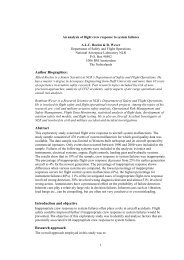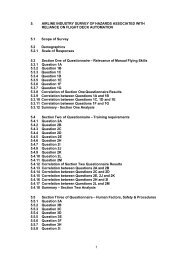Causal risk models of air transport - NLR-ATSI
Causal risk models of air transport - NLR-ATSI
Causal risk models of air transport - NLR-ATSI
You also want an ePaper? Increase the reach of your titles
YUMPU automatically turns print PDFs into web optimized ePapers that Google loves.
advancement in ATM on the other hand has been relatively slow because ATM has<br />
traditionally been the responsibility <strong>of</strong> national authorities and therefore has, until<br />
recently 21 , not experienced the effects <strong>of</strong> competition. A result is the use <strong>of</strong> technology that<br />
basically dates from WW II; VHF voice communication and radar.<br />
Regulatory requirements matured. Strength requirements for <strong>air</strong>craft structures were<br />
specified in terms <strong>of</strong> limit loads (the maximum loads to be expected in service) and<br />
ultimate loads (limit loads multiplied by prescribed factors <strong>of</strong> safety <strong>of</strong> 1.5). Aircraft<br />
manufacturers had to show compliance to these requirements by analysis supported by<br />
strength testing <strong>of</strong> sub-components, full scale components or full scale tests <strong>of</strong> assembled<br />
components (such as a nearly complete <strong>air</strong>frame) up to limit loads and ultimate loads. The<br />
structure must be able to support ultimate loads without failure for at least 3 seconds. When<br />
tests are used to show compliance, an additional safety factor <strong>of</strong> 1.15 is typically applied to<br />
account for variability in material properties [EASA 2003a].<br />
Regulatory requirements regarding <strong>air</strong>craft system safety also evolved. When automatic<br />
landing systems were designed in the 1950’s, <strong>air</strong>craft and equipment manufacturers asked<br />
the <strong>air</strong>worthiness authorities what requirements or special conditions would be applied to<br />
such systems. The authorities did not consider that they had the background and experience<br />
to write detailed requirements. Instead a target level <strong>of</strong> safety was agreed with the<br />
manufacturers as a base for certification. Applicants were required to make a case for their<br />
individual systems by assessing them against the declared objective. Subsequently detailed<br />
methods <strong>of</strong> establishing compliance were evolved. With the further development <strong>of</strong><br />
technology and complex systems, in particular related to supersonic <strong>transport</strong> <strong>air</strong>craft, the<br />
authorities from the USA, UK and France produced requirements that included the general<br />
principle that an inverse relationship should exist between the probability <strong>of</strong> occurrence<br />
and the degree <strong>of</strong> hazard inherent in its effect on the capability <strong>of</strong> the <strong>air</strong>craft. In addition,<br />
they specified a level <strong>of</strong> safety to be achieved, in qualitative and quantitative terms, and<br />
required that a safety assessment should be made. The concept <strong>of</strong> requiring an inverse<br />
relationship between probability <strong>of</strong> failure and the severity <strong>of</strong> the failure effect had in<br />
practice been established from the early days <strong>of</strong> aviation and resulted in, for instance, twin<br />
magnetos and twin spark plugs on engines, dual wing rigging wires and dual control cables.<br />
What was new in the requirements was the introduction <strong>of</strong> quantitative and numerical<br />
methods for addressing <strong>risk</strong> instead <strong>of</strong> the intuitive methods that had been used before<br />
[Lloyd 1980, Lloyd & Tye 1982]. In assessing the acceptability <strong>of</strong> a system design it was<br />
recognised that rational probability values would have to be established. Historical<br />
evidence indicated that the <strong>risk</strong> <strong>of</strong> a serious accident due to operational and <strong>air</strong>frame-related<br />
causes was approximately 1 per million hours <strong>of</strong> flight. Furthermore, about 10 percent <strong>of</strong><br />
the total could be (albeit arbitrarily) attributed to failure conditions caused by the <strong>air</strong>craft’s<br />
systems problems. It seemed reasonable that serious accidents caused by systems should<br />
not be allowed a higher probability than this in new <strong>air</strong>craft designs. It was thereby possible<br />
to require for new designs that the probability <strong>of</strong> a serious accident from all such system<br />
failure conditions be no greater than 1 per ten million flight hours, or 1 x 10 -7 per flight<br />
hour. As it is not possible to say whether the target has been met until all the systems on the<br />
<strong>air</strong>craft are collectively analysed numerically, it was assumed, arbitrarily, that there are<br />
retirement. The probability that at some point in his entire career he will have had to shutdown<br />
an engine in-flight is approximately 1 in 5.<br />
21<br />
ANSPs in Europe are becoming more independent from the national authorities; NATS<br />
in the UK for example is fully privatised and LVNL in the Netherlands is a ‘Zelfstandig<br />
bestuursorgaan’.<br />
37




